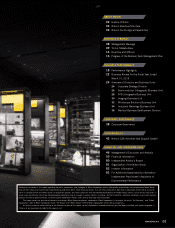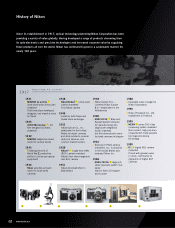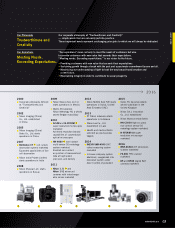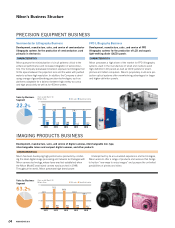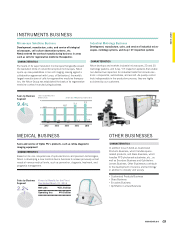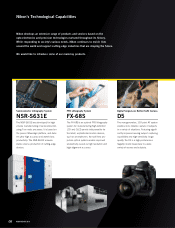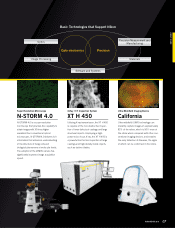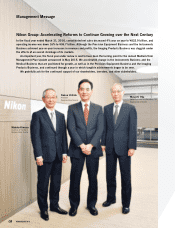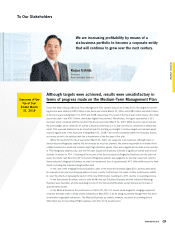Nikon 2016 Annual Report Download - page 13
Download and view the complete annual report
Please find page 13 of the 2016 Nikon annual report below. You can navigate through the pages in the report by either clicking on the pages listed below, or by using the keyword search tool below to find specific information within the annual report.
Outlook for the
Fiscal Year
Ending March
31, 2017
A year to strengthen the foundation to make Nikon’s vision of
its future more concrete
With regard to the effects of the April 2016 Kumamoto Earthquake on Company performance, the supply chain of
the Imaging Products Business was the worst hit. As supplier recovery had still been in progress, forecasts for the
scal year ending March 31, 2017, which were announced in May 2016 on the basis of information then available,
are anticipating increases in both Companywide sales and operating income, as rm growth is expected from both
the Precision Equipment Business and the Instruments Business. Although there are uncertainties, the Imaging
Products Business plans to have recovered, including its full production system of its mainstay digital SLR, in the
second half of the scal year, and I would like to minimize the extent of the decrease in prot over the full year.
Under the Medium-Term Management Plan Update, we decided that the operating income target for the scal
year ending March 31, 2017, would be ¥38.0 billion, but currently we are planning on ¥46.0 billion. In the initial
year we were able to improve from ¥30.0 billion to ¥36.7 billion, and expect to improve from ¥38.0 billion to ¥46.0
billion in the second year. If it transpires that we achieve the plan two years in succession, it may seem that the
reform initiatives have already borne fruit and that we are in a strong position. However, as the majority of the factors
contributing to the increased income for the period will be due to the signicant growth in sales of FPD lithography
systems associated with burgeoning demand for small and medium-sized high-denition panels spilling over from
Issues to Be
Addressed
Nurturing human resources with a mind-set that creates value
added and encourages the taking of action
The scal year ended March 31, 2016, can be assessed as one in which there were achievements made from the
cost reduction standpoint in the Imaging Products Business in particular. As a result of having consolidated its
production and sales, moving away from compact digital cameras, where demand was falling, and focusing instead
on middle and high-end digital SLR cameras, where demand remained stable, as well as having carried out thorough
cost reductions along the length of the supply chain, the Imaging Products Business maintained an operating
income ratio of 8.8%, despite year-on-year decreases in net sales and operating income. As cost reductions are
a mandatory management measure for manufacturers, we will continue to promote them on an ongoing basis,
not only in the Imaging Products Business but across the Nikon Group as a whole.
A factor that again came to the fore during the course of the initial year of the Medium-Term Management Plan
was that a transformation in the Company’s mind-set is still being developed. If I had to give one example of an
achievement, however, it would be the solutions-based proposals in the Industrial Metrology Business. The scale of
the business itself is not large, but while incorporating a succession of new perspectives, proposing solutions to
customers bore fruit in a variety of ways. Rather than the mind-set of simply performing a task with a conventional
platform that is already in place, we need people with a mind-set that continually creates our own value added.
Causing that mind-set to become more deeply ingrained throughout the Company is recognized as a major challenge.
While breaking out of our shell and taking a bird’s eye view of the value chain, starting from the business area for
which we are responsible, we will venture into adjacent areas. I would like to greatly increase the number of employees
who possess this kind of mind-set, which also encourages them to take action. To realize Transform to Grow,
we have introduced the human resource measure known as the FUTURE IN FOCUS, by which each and every
employee is encouraged to change his or her way of thinking. Making steady progress with the measure, we will
accelerate the further improvement of our human resource capabilities.
It is necessary to further accelerate the reassignment of personnel to growth businesses. For example, we have
implemented certain personnel transfers, such as from the Semiconductor Lithography Business to the Medical
Business, but we are considering additional reassignments to strengthen the growth businesses.
To Our Stakeholders
11
NIKON REPORT 2016
BUSINESS STRATEGY


